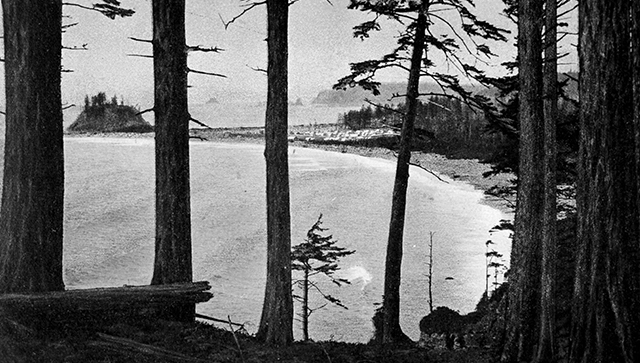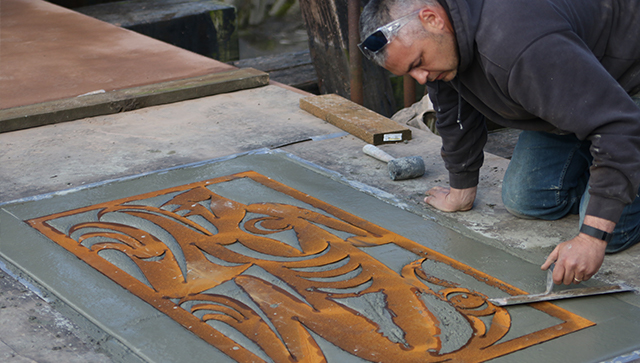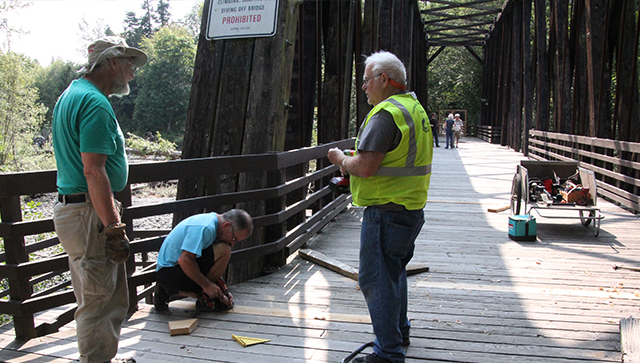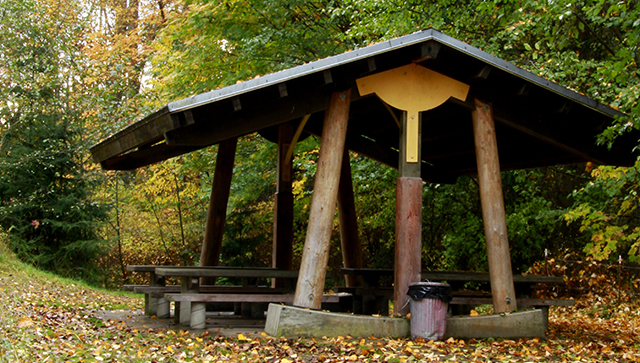Railroad Bridge Park
Admission to Railroad Bridge Park and the
Dungeness River Nature Center is free.
Forest canopy and farmer’s fields adjacent to the trail offer great birdwatching and has been designated as an “Important Bird Area” by the National Audubon Society for its importance to bird breeding and migration. Eagles, hawks, songbirds and migrating cackling geese, snow geese and trumpeter swans are frequent visitors.
Low bank access to the river at Railroad Bridge Park is by a network of primitive trails. Although the river offers quiet pools and shallow water, use caution with children! The current in main channels can be dangerously swift and the river riddled with logjams.
Amenities at the park include a coffee bar, seating on the River Center’s plaza, public restrooms, bike repair stand, interpretive signage, and an exhibits room in the River Center dedicated to the natural and cultural history of the Dungeness River watershed.
- Railroad Bridge Park is 75 wooded acres with riverfront access to a wild stretch of the Dungeness River, just one mile from Sequim city limits.
- Park at the Dungeness River Nature Center and cross the river on the adjacent Olympic Discovery Trail. The non-motorized trail crosses Dungeness River on a historic railway trestle with smooth bridge-decking and safety rails.
- From the bridge safely observe the ever-changing seasons, riparian forest, seasonal salmon spawning, and dynamics of the Dungeness River.
The Dungeness River Audubon Center
at Railroad Bridge Park
An active partnership of three organizations operating under a Memorandum of Understanding (MOU)
Original Partners
- Rainshadow Natural Science Foundation (renamed “River Center Foundation”)
- Jamestown S’Klallam Tribe
Partners added in 2017
- Olympic Peninsula Audubon Society
- National Audubon Society (NAS) represented by Audubon Washington, the WA State Office of NAS.

Sequim Natural History Museum
The story of our museum begins with the Sequim Natural History Museum which for nine years was an adjunct of the Sequim School District, created and maintained entirely by volunteers. In 1993 the museum’s space in the old high school building had to be relinquished for school district use, and the specimens and exhibit materials were stored.
Image from Washington Rural Heritage, the Community Digital Archives for Washington State.
Soon thereafter, the museum took advantage of a unique opportunity to reorganize as a nonprofit corporation — the Rainshadow Natural Science Foundation — and to join forces with the Jamestown S’Klallam Tribe in a partnership to interpret the natural history of the river, the watershed, and the Olympic Peninsula.

A Fresh Start
The Rainshadow Natural Science Foundation needed a permanent home for its displays and a facility for educational programs. The Jamestown S’Klallam Tribe has always been deeply involved with the well-being of the Dungeness River and the restoration of the salmon.
The Railroad Bridge Park, dedicated in 1992, is an exceptional setting for an interpretive center. It was natural for the Foundation and the Tribe to cooperate in working toward these compatible goals by developing the River Center.

Renovating the Area
In 1992, many volunteers helped replace the railroad ties and planked deck of the former railroad bridge. The approach trestle provides elevated views into the woodland canopy as well as varied river vistas. A nature trail provides glimpses of local wildlife and the native plants and trees.
The bridge and trestle, and the river-edge trails, provide opportunities for visitors to experience an ever-changing river channel and the contrast of summer quiet to winter storms.
The Railroad Bridge and trestle were completely planked in restoration for pedestrian and bicycle access. Projecting alcoves and occasional seating areas along the railings allow for quiet viewing out of the traffic zone. The ramp structure at the east bridge end provides easy access for physically-challenged visitors.
Broad pathways of paver-stones laid by volunteers provide easy access to the RiverStage, the RiverShed and the east approach ramp of the Railroad Bridge.

The River Shed
An elegant timber-frame shelter with permanent picnic tables and benches — provides a quiet setting in the woods near the river for programs and casual gatherings.
The shelter was completed in the autumn of 1995, using donated materials and volunteer labor together with grant funding, with design by Ken Hays, a Sequim Architect.

The River Stage
An open amphitheater with stage and seating for 75. It was designed and constructed by local volunteers with grant funding and local volunteer labor, with construction leadership and supervision by Chas Bridge and design by Ken Wiersema. It was completed in late spring 1997 and first used for the summer River Talks.
Photo from Washington Rural Heritage, the Community Digital Archives for Washington State.
An open amphitheater with stage and seating for 75. It was designed and constructed by local volunteers with grant funding and local volunteer labor, with construction leadership and supervision by Chas Bridge and design by Ken Wiersema. It was completed in late spring 1997 and first used for the summer River Talks.

The River Center
The planning and construction of the River Center interpretive building are complete, and the Grand Opening was celebrated on 21 October 2001. The 1,600 sq ft building provides exhibit, classroom/lab, and meeting space, and supporting facilities.
The multi-purpose space of the Center building includes scientific exhibits, hands-on displays, physical specimens, classroom study aids, and reference library materials.
Computer database and multimedia presentation capabilities are provided in the new Center building to support classroom studies, audience programs and technical workgroup sessions.
Olympic Peninsula Audubon meets on the third Wednesday of the month in the Center building for its programs about environmental interpretation and nature study, typically attended by 40-60 members.

